Chinese_culture_中国传统文化介绍
- 格式:pptx
- 大小:5.41 MB
- 文档页数:52
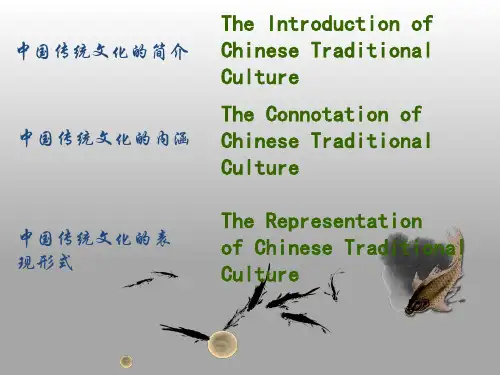
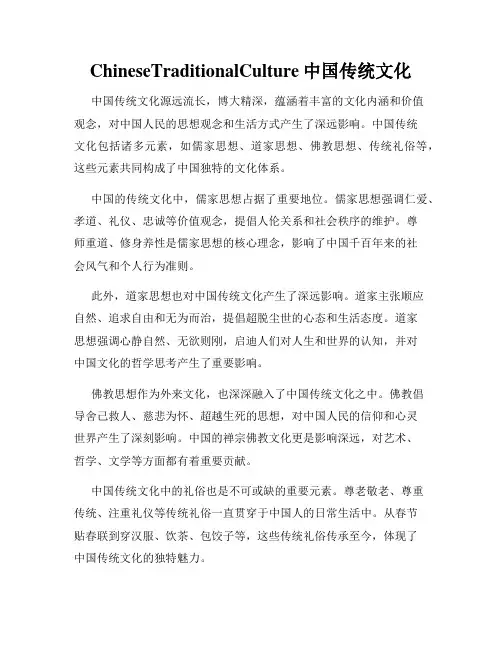
ChineseTraditionalCulture中国传统文化中国传统文化源远流长,博大精深,蕴涵着丰富的文化内涵和价值观念,对中国人民的思想观念和生活方式产生了深远影响。
中国传统文化包括诸多元素,如儒家思想、道家思想、佛教思想、传统礼俗等,这些元素共同构成了中国独特的文化体系。
中国的传统文化中,儒家思想占据了重要地位。
儒家思想强调仁爱、孝道、礼仪、忠诚等价值观念,提倡人伦关系和社会秩序的维护。
尊师重道、修身养性是儒家思想的核心理念,影响了中国千百年来的社会风气和个人行为准则。
此外,道家思想也对中国传统文化产生了深远影响。
道家主张顺应自然、追求自由和无为而治,提倡超脱尘世的心态和生活态度。
道家思想强调心静自然、无欲则刚,启迪人们对人生和世界的认知,并对中国文化的哲学思考产生了重要影响。
佛教思想作为外来文化,也深深融入了中国传统文化之中。
佛教倡导舍己救人、慈悲为怀、超越生死的思想,对中国人民的信仰和心灵世界产生了深刻影响。
中国的禅宗佛教文化更是影响深远,对艺术、哲学、文学等方面都有着重要贡献。
中国传统文化中的礼俗也是不可或缺的重要元素。
尊老敬老、尊重传统、注重礼仪等传统礼俗一直贯穿于中国人的日常生活中。
从春节贴春联到穿汉服、饮茶、包饺子等,这些传统礼俗传承至今,体现了中国传统文化的独特魅力。
总的来说,中国传统文化以其博大精深、内涵丰富的特点,影响和启迪着中国人民的思想观念和行为准则。
传承和弘扬中国传统文化,不仅能够加深人们对中华传统的认知和理解,更能够激发人们对传统价值的珍视和传承。
在当今社会,我们应该更加重视中国传统文化的传承与发展,将其珍贵的文化遗产传承给后代,让中国传统文化的光芒继续照耀人们的心灵。
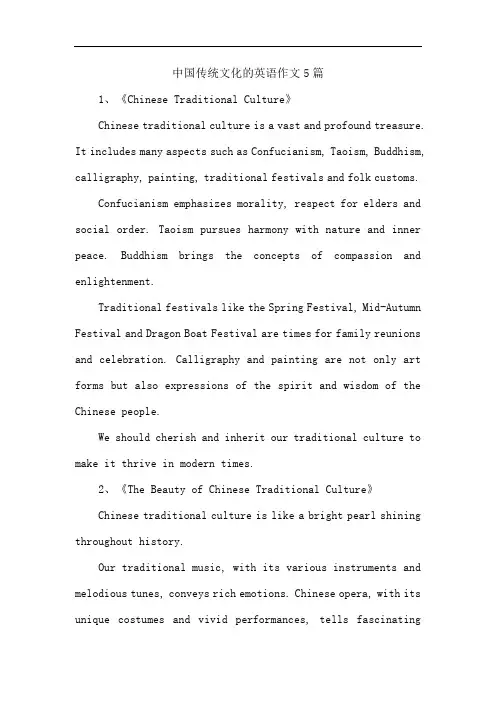
中国传统文化的英语作文5篇1、《Chinese Traditional Culture》Chinese traditional culture is a vast and profound treasure. It includes many aspects such as Confucianism, Taoism, Buddhism, calligraphy, painting, traditional festivals and folk customs.Confucianism emphasizes morality, respect for elders and social order. Taoism pursues harmony with nature and inner peace. Buddhism brings the concepts of compassion and enlightenment.Traditional festivals like the Spring Festival, Mid-Autumn Festival and Dragon Boat Festival are times for family reunions and celebration. Calligraphy and painting are not only art forms but also expressions of the spirit and wisdom of the Chinese people.We should cherish and inherit our traditional culture to make it thrive in modern times.2、《The Beauty of Chinese Traditional Culture》Chinese traditional culture is like a bright pearl shining throughout history.Our traditional music, with its various instruments and melodious tunes, conveys rich emotions. Chinese opera, with its unique costumes and vivid performances, tells fascinatingstories.The art of paper-cutting and embroidery showcases the exquisite craftsmanship of the Chinese people. Moreover, traditional Chinese medicine, based on thousands of years of practice, offers natural and effective ways to maintain health.Chinese traditional culture is the root of our nation. We have the responsibility to protect and pass it on.3、《The Richness of Chinese Traditional Culture》China has a long and splendid traditional culture.The cuisine is one of the outstanding parts. With diverse cooking methods and countless delicious dishes, it reflects the wisdom and creativity of the Chinese.The philosophy of Laozi and Zhuangzi provides profound thoughts on life and the universe. The traditional architecture, like the Forbidden City and ancient gardens, demonstrates the exquisite design and unique style.Chinese traditional culture also includes martial arts, which not only train the body but also cultivate the spirit.Let's carry forward this precious heritage and make it known to the world.4、《Inheritance of Chinese Traditional Culture》Chinese traditional culture is an invaluable asset.It encompasses ancient poetry and prose that convey deep emotions and thoughts. The traditional dance forms, with their graceful movements, are a visual treat.The customs and etiquette passed down through generations teach us respect and courtesy. Handicrafts like ceramics and weaving represent the diligence and skill of our ancestors.We must actively inherit and promote our traditional culture to ensure its continuous development and prosperity.5、《The Significance of Chinese Traditional Culture》Chinese traditional culture holds great significance.It shapes our national identity and sense of belonging. The values and morals derived from it guide our behavior and thinking.Traditional culture also enhances our cultural confidence and pride. It helps us understand our history and ancestors' wisdom.For example, the concept of harmony in Confucianism promotes peaceful coexistence. The spirit of perseverance in ancient stories inspires us to overcome difficulties.We should cherish and pass on this precious heritage.。
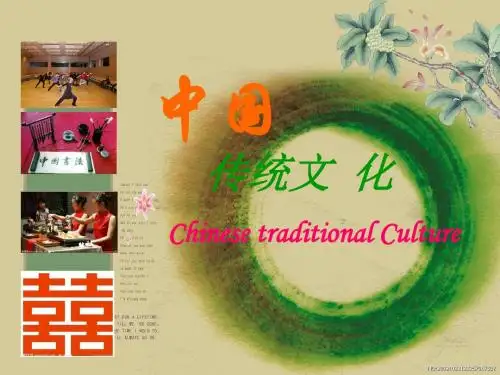
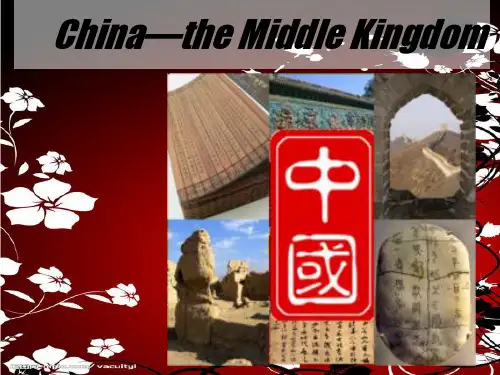
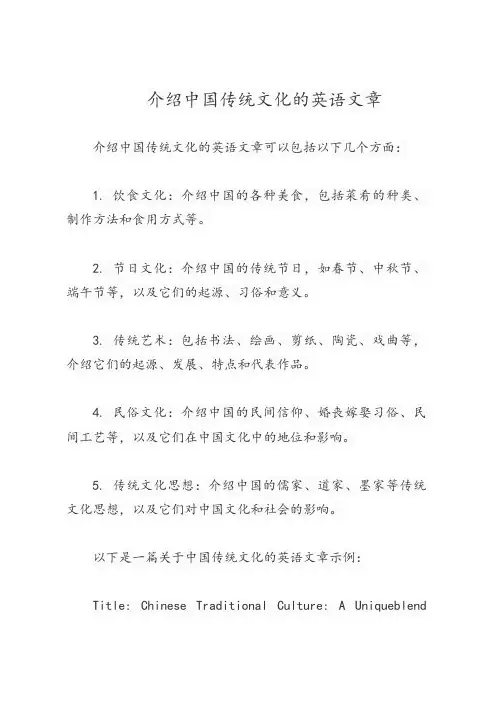
介绍中国传统文化的英语文章介绍中国传统文化的英语文章可以包括以下几个方面:1. 饮食文化:介绍中国的各种美食,包括菜肴的种类、制作方法和食用方式等。
2. 节日文化:介绍中国的传统节日,如春节、中秋节、端午节等,以及它们的起源、习俗和意义。
3. 传统艺术:包括书法、绘画、剪纸、陶瓷、戏曲等,介绍它们的起源、发展、特点和代表作品。
4. 民俗文化:介绍中国的民间信仰、婚丧嫁娶习俗、民间工艺等,以及它们在中国文化中的地位和影响。
5. 传统文化思想:介绍中国的儒家、道家、墨家等传统文化思想,以及它们对中国文化和社会的影响。
以下是一篇关于中国传统文化的英语文章示例:Title: Chinese Traditional Culture: A Uniqueblendof Past and PresentChina, a country with a long history and diverse culture, has many traditional elements that make it unique. One of the most prominent aspects of Chinese culture is its food, which has a variety of flavors and cooking techniques that are appreciated worldwide. From the simplicity of rice and noodles to the complexity of delicately crafted soups and stews, Chinese cuisine is a reflection of the country's diverse landscape and climate.Another important aspect of Chinese culture is its rich traditional festivals. From the solemnity of the Spring Festival to the joy of the Mid-Autumn Festival, Chinese festivals have their own unique customs and symbols that reflect the values of the Chinese people. These festivals not only bring people together but also serve as a way for the Chinese to reflect on their past and look forward to the future.In terms of art, Chinese culture is represented byvarious traditional forms, including calligraphy, painting, paper cutting, pottery, and more. These art forms not only serve as beautiful decorations but also reflect the thoughtfulness and creativity of the Chinese people. From Taoist symbolism to Feng Shui principles, Chinese art is full of hidden meanings that require deeper exploration.Finally, Chinese culture is also characterized by its traditional beliefs and customs. From funeral rites to wedding ceremonies, Chinese culture has its own unique ways of celebrating life's important moments. Additionally, there are various folk arts and crafts that have been passed down through generations, such as embroidery, pottery, and more. These traditional practices not only serve as beautiful art forms but also contribute to the rich tapestry of Chinese culture.In conclusion, Chinese culture is a complex blend of past and present, with elements from different eras still present in modern society. From food to festivals to art to beliefs and customs, Chinese culture has alot to offer, both to the Chinese people and to the world at large.。
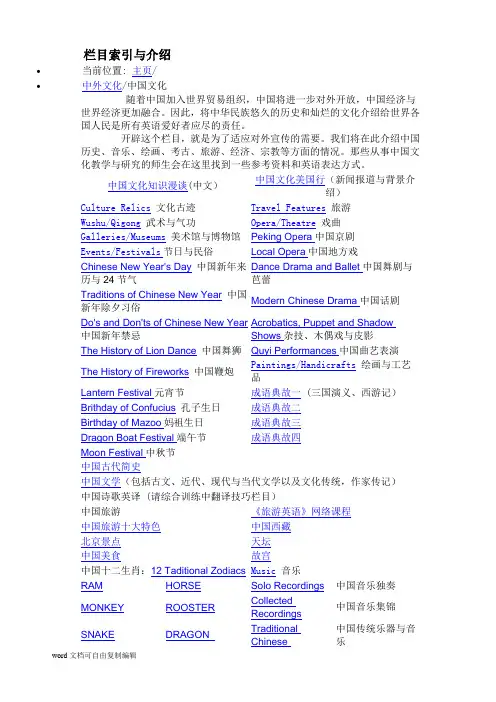
栏目索引与介绍•当前位置: 主页/•中外文化/中国文化随着中国加入世界贸易组织,中国将进一步对外开放,中国经济与世界经济更加融合。
因此,将中华民族悠久的历史和灿烂的文化介绍给世界各国人民是所有英语爱好者应尽的责任。
开辟这个栏目,就是为了适应对外宣传的需要。
我们将在此介绍中国历史、音乐、绘画、考古、旅游、经济、宗教等方面的情况。
那些从事中国文化教学与研究的师生会在这里找到一些参考资料和英语表达方式。
中国文化知识漫谈(中文)中国文化美国行(新闻报道与背景介绍)Culture Relics文化古迹Travel Features旅游Wushu/Qigong武术与气功Opera/Theatre戏曲Galleries/Museums美术馆与博物馆Peking Opera中国京剧Events/Festivals节日与民俗Local Opera中国地方戏Chinese New Year's Day中国新年来历与24节气Dance Drama and Ballet中国舞剧与芭蕾Traditions of Chinese New Year中国新年除夕习俗Modern Chinese Drama中国话剧Do's and Don'ts of Chinese New Year 中国新年禁忌Acrobatics, Puppet and Shadow Shows杂技、木偶戏与皮影The History of Lion Dance中国舞狮Quyi Performances中国曲艺表演The History of Fireworks中国鞭炮Paintings/Handicrafts绘画与工艺品Lantern Festival元宵节成语典故一 (三国演义、西游记)Brithday of Confucius孔子生日成语典故二Birthday of Mazoo妈祖生日成语典故三Dragon Boat Festival端午节成语典故四Moon Festival中秋节中国古代简史中国文学(包括古文、近代、现代与当代文学以及文化传统,作家传记)中国诗歌英译 (请综合训练中翻译技巧栏目)中国旅游《旅游英语》网络课程中国旅游十大特色中国西藏北京景点天坛中国美食故宫中国十二生肖:12 Taditional Zodiacs M usic音乐RAM HORSE Solo Recordings中国音乐独奏MONKEY ROOSTER CollectedRecordings中国音乐集锦SNAKE DRAGON TraditionalChinese中国传统乐器与音乐InstrumentalmusicDOG PIG Classical Music中国古典音乐OX TIGERRABBIT RAT中国文化知识漫谈(一)文化的含义什么叫文化?《易经》上说:“观乎天文,以察时变,观乎人文,以化成天下。
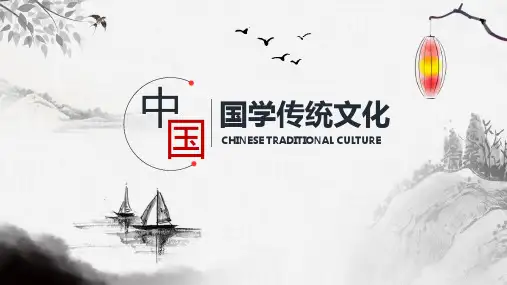
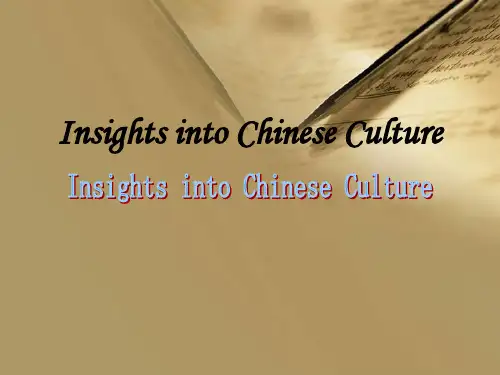
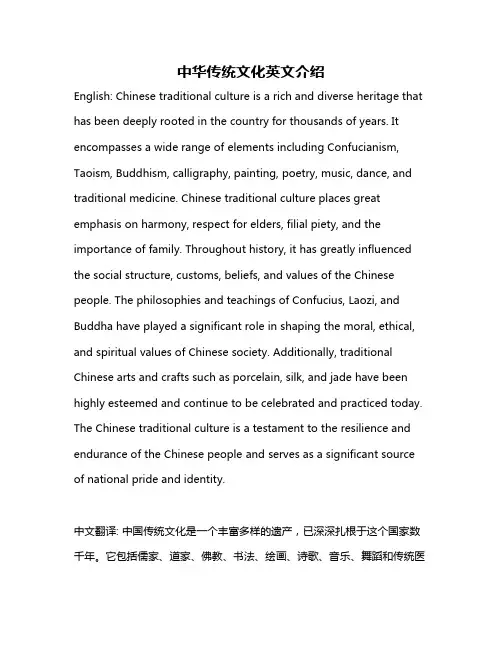
中华传统文化英文介绍English: Chinese traditional culture is a rich and diverse heritage that has been deeply rooted in the country for thousands of years. It encompasses a wide range of elements including Confucianism, Taoism, Buddhism, calligraphy, painting, poetry, music, dance, and traditional medicine. Chinese traditional culture places great emphasis on harmony, respect for elders, filial piety, and the importance of family. Throughout history, it has greatly influenced the social structure, customs, beliefs, and values of the Chinese people. The philosophies and teachings of Confucius, Laozi, and Buddha have played a significant role in shaping the moral, ethical, and spiritual values of Chinese society. Additionally, traditional Chinese arts and crafts such as porcelain, silk, and jade have been highly esteemed and continue to be celebrated and practiced today. The Chinese traditional culture is a testament to the resilience and endurance of the Chinese people and serves as a significant source of national pride and identity.中文翻译: 中国传统文化是一个丰富多样的遗产,已深深扎根于这个国家数千年。
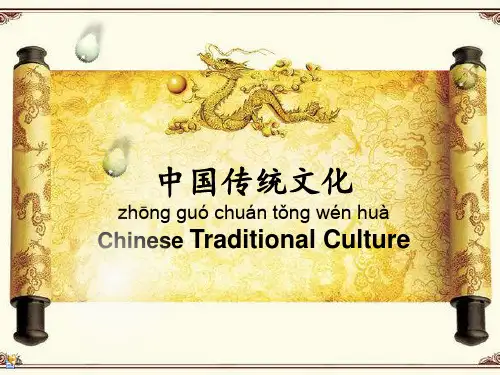
Introduction to Chinese TraditionalCultureChina, with a history spanning over 5,000 years, boasts a rich and profound traditional culture that has shaped the country's identity and influenced countless aspects of daily life. This document aims to provide an overview of Chinese traditional culture, highlighting its key elements and their significance in Chinese society.1. Language and Literature2. Philosophy and ReligionChinese traditional culture is deeply rooted in Confucianism, Taoism, and Buddhism. Confucianism emphasizes the importance of moral integrity, respect for authority, and the pursuit of harmony in relationships. Taoism advocates for a simple, natural life and the pursuit of inner peace. Buddhism, introduced from India, has integrated with Chinese culture, influencing art, architecture, and everyday life.3. Art and CraftsmanshipChinese art is renowned for its exquisite craftsmanship and aesthetic appeal. Traditional Chinese painting, calligraphy, and porcelain are highly valued worldwide. The art of silk weaving, papermaking, and jade carving showcasesthe ingenuity and skill of Chinese artisans. Moreover, the practice of Feng Shui, which aims to harmonize the flow of energy in a space, reflects the Chinese belief in the interconnectedness of nature and human life.4. Festivals and CustomsChinese festivals are a vibrant display of the country's cultural heritage. The Spring Festival (Chinese New Year) is the most important holiday, featuring traditional activities such as dragon and lion dances, fireworks, and family reunions. Other notable festivals include the Lantern Festival, Dragon Boat Festival, and MidAutumn Festival, each with its unique customs and traditions.5. Traditional ClothingThe Hanfu, a traditional Chinese attire, reflects the elegance and diversity of Chinese culture. Characterized its flowing lines and vibrant colors, Hanfu represents different social status, occasions, and historical periods. The Tang suit and Qipao are also iconic examples of Chinesetraditional clothing, showcasing the beauty and grace of Chinese women.In conclusion, Chinese traditional culture is a treasure trove of wisdom, art, and values that continue to shape the lives of people in China and around the world. By exploringthese cultural elements, we can gain a deeper understandingof the Chinese perspective on life, nature, and humanity.6. Culinary DelightsChinese cuisine is a vital part of its traditional culture, renowned for its diversity and emphasis on harmonyin flavors and ingredients. The practice of using a pair of chopsticks is not only a dining custom but also a reflectionof Chinese philosophy. Signature dishes such as Peking duck, hot pot, dim sum, and Sichuan spicy tofu (Mapo tofu)represent the rich tapestry of regional cuisines within China. The art of tea making and tea ceremonies further illustratethe Chinese pursuit of balance and tranquility in daily life.7. Architecture and GardensChinese architecture is characterized its use of wood, intricate carvings, and upturned eaves. The Forbidden City in Beijing and the classical gardens of Suzhou are prime examples of Chinese architectural excellence. Thesestructures are not only beautiful but also embody theprinciples of Feng Shui and the concept of harmony between humanity and nature. The gardens, in particular, are designed to mimic natural landscapes, providing a serene environmentfor contemplation and relaxation.8. Music and DanceChinese traditional music, with its unique scales and instruments such as the guzheng (zither), erhu (fiddle), and pipa (lute), creates a distinctive sound that is both soothing and evocative. Chinese classical dance, often performed in colorful costumes with flowing movements, tells stories and expresses emotions, drawing from historical legends and folk tales. The Peking Opera, with its elaborate costumes, makeup, and singing styles, is a famous form of traditional Chinese performing art.9. Martial Arts10. Social EtiquetteChinese society places a strong emphasis on respect, modesty, and humility. The concept of "face" (mianzi) is crucial in social interactions, representing one's reputation and social standing. Traditional greetings, such as bowing or clasping hands, and the exchange of business cards with both hands, demonstrate the importance of etiquette in Chinese culture. The practice of giftgiving, with its specific customs and taboos, is also a reflection of the respect and consideration shown in relationships.In exploring the depths of Chinese traditional culture, one cannot help but be inspired its richness and the enduring legacy it has left on the world. It is a culturethat invites us to look inward, to appreciate the beauty in simplicity, and to find harmony in the world around us.11. Folklore and MythologyChinese folklore and mythology are a tapestry of stories and legends that have been passed down through generations. These tales often feature mythical creatures like the dragon, phoenix, and qilin, which symbolize power, prosperity, and good fortune. Stories such as "Journey to the West," "Water Margin," and "The Investiture of the Gods" are not only literary masterpieces but also reflect the moral values and cultural norms of ancient China. These myths and legends continue to influence modern Chinese literature, film, and popular culture.12. Traditional Medicine13. Family ValuesFamily is the cornerstone of Chinese society, and traditional values place a strong emphasis on filial piety and ancestor worship. Elders are respected for their wisdom and experience, and the concept of "family" extends beyond the nuclear unit to include extended relatives. The family name (surname) is a source of pride and identity, often passed down through generations with a sense of duty to honor one's ancestors. The importance of family is reflected in thecelebration of festivals, where family reunions are a central tradition.14. Education and the Art of LearningEducation has always been highly valued in Chinese culture, with a focus on the pursuit of knowledge and the cultivation of moral character. The ancient Chinese education system emphasized the Four Arts: qin (a string instrument), shu (calligraphy), hua (painting), and qi (the game of Go). Today, the Chinese education system continues to be rigorous, with a strong emphasis on academic achievement and the Confucian values of respect for teachers and the importance of learning.15. Ceremonies and RitualsChinese culture is rich with ceremonies and rituals that mark life's milestones, such as births, weddings, and funerals. These events are often steeped in tradition, with specific customs and rituals that have been followed for centuries. For instance, Chinese weddings are filled with symbolic gestures, such as the exchange of red envelopes (hongbao), the tea ceremony, and the wearing of traditional attire. These rituals are not only celebratory but also serve to reinforce cultural identity and continuity.In conclusion, the depth and breadth of Chinesetraditional culture are truly aweinspiring. It is a livingheritage that continues to evolve while maintaining its roots in ancient wisdom. By understanding and appreciating these cultural elements, we gain insight into the soul of a civilization that has shaped and continues to shape the world in countless ways.。
中国传统文化英文介绍Chinese traditional culture is a rich and diverse heritage that has been developed and refined over thousands of years. It encompasses various aspects such as philosophy, literature, art, cuisine, and more.One of the most well-known aspects of Chinese traditional culture is Confucianism. Confucian teachings emphasize filial piety, respect for elders, and the importance of moral values in personal and social relationships. These teachings have greatly influenced the social structure and ethical values in Chinese society.Chinese traditional literature has a long history, with classic works such as "The Book of Songs," "Dream of the Red Chamber," and "Journey to the West." These literary achievements not only provide insight into ancient Chinesesociety but also reflect the values, aspirations, and wisdom of the Chinese people.Chinese traditional art covers various forms, including calligraphy, painting, sculpture, and traditional Chinese opera. Chinese calligraphy is regarded as a visual expression of one's inner thoughts and emotions, with its graceful strokes and intricate characters. Traditional Chinesepainting often features the natural beauty of landscapes, using a brush and ink to create a sense of serenity and harmony.Chinese traditional cuisine is known for its diverse flavors and cooking techniques. It places great emphasis on the balance of taste, texture, and color. Key ingredients such as rice, noodles, soybeans, and various spices are used to create a wide range of dishes, each with their unique regional characteristics.Another important aspect of Chinese traditional culture is festivals. Festivals such as the Spring Festival (Chinese New Year), Mid-Autumn Festival, and Dragon Boat Festival are celebrated with various traditional customs and activities. These festivals not only bring families together but also showcase the rich cultural heritage of China.Overall, Chinese traditional culture is a treasure trove of wisdom, aesthetics, and traditions that have been passed down through generations. It continues to shape the lives and values of the Chinese people, contributing to the unique identity and splendor of Chinese civilization.。
大学英语作文:中国传统文化ChineseTraditional Culture导读:本文大学英语作文:中国传统文化Chinese Traditional Culture,仅供参考,如果觉得很不错,欢迎点评和分享。
中国有着5000多年的历史,我们为这个源远流长的文化感到骄傲。
每年,我们都很期待在传统节日里度假,它们是中国传统文化的重要组成部分。
但对年轻人来说,这些节日的意义正在消退。
When young people are asked about the meaning of traditional festival, some of them have no idea. For example, some young people believe that Mid-autumn Festival is to in honor of the ancestors, or it is a day to eat mooncake. Actually, most festivals have been advocated by the commercial ads, and they show people to buy more products to spend the festivals happily. Some ads try to implant people the wrong idea about the meaning of festival, just to attract more customers.当年轻人被问及传统节日的意义时,有些人根本就不知道。
例如,一些年轻人认为中秋节是为了纪念祖先,或者是用来吃月饼的日子。
事实上,大多数节日都被商业广告进行宣传,他们让人们购买更多的产品来欢度节日。
一些广告还试图植入人们对节日意义的错误观念,只是为了吸引更多的顾客。
The loss meaning of traditional festivals brings the negative side to the preserve of traditional culture. The mass media should advocate the essence of the festivals, so as to let the young generation learn more about our culture and be proud of it. 传统节日意义的缺失给传统文化的传承带来了消极影响。
中国传统文化英文介绍Chinese Traditional CultureChinese traditional culture is a rich and ancient heritage that has shaped the country’s history, values, and way of life. It encompasses various aspects, including philosophy, literature, art, music, cuisine, medicine, and martial arts.One key aspect of Chinese traditional culture is Confucianism, which emphasizes the importance of moral values, social harmony, and filial piety. Confucian teachings have had a profound influence on Chinese society, promoting virtues such as respect for elders, loyalty, and the pursuit of knowledge.Chinese literature is also highly regarded, with classic works like “Dream of the Red Chamber“ and “Journey to the West“ showcasing th e country’s rich storytelling traditions. Poetry, especially the works of renowned poets like Li Bai and Du Fu, is revered for its elegance and profound meaning.Chinese art is diverse and encompasses various forms, including calligraphy, painting, sculpture, and ceramics. Calligraphy, known as the “art of writing,“ is considered a form of self-expression and is highly valued for its aesthetic beauty. Traditional Chinese painting often depicts landscapes, flowers, and birds, with an emphasis on capturing the essence and spirit of the subject.In terms of music, traditional Chinese instruments such as the guzheng, pipa, and erhu produce distinctive sounds that reflect the country’s cultural heritage. Chinese opera, with its colorful costumes, intricate makeup, and stylized movements, is a unique form of performing arts that combines music, dance, and drama.Chinese cuisine is renowned for its variety, flavors, and regional specialties. From Cantonese dim sum to Sichuan spicy hotpot, each region has its own culinary traditions and signature dishes. Chinese tea culture isalso deeply rooted in tradition and is known for its meditative and social aspects.Traditional Chinese medicine, based on the principles of balancing Yin and Yang and promoting Qi flow, has been practiced for thousands of years. It includes treatments such as acupuncture, herbal medicine, and qigong exercises, which focus on maintaining harmony between the body, mind, and spirit.Overall, Chinese traditional culture embodies a deep reverence for history, harmony with nature, and a strong sense of community. It continues to influence and inspire people around the world, serving as a testament to the richness and resilience of Chinese civilization.。